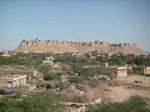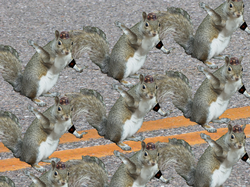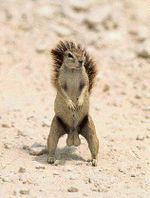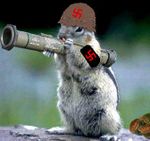Gray squirrel
| Gray Squirrel | |
|---|---|
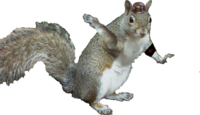 | |
| Scientific classification | |
| Domain | Eukarya |
| Kingdom | Animilia |
| Phylum | Chordata |
| Class | Mammalia |
| Order | Rodentia |
| Family | Sciuridae |
| Genus | Sciurus |
| Species | S. carolinensis |
| Binomial name | |
| Sciurus carolinensis | |
| Specifications | |
| Primary armament | Razor Sharp Teeth 1d6 + 1 |
| Secondary armament | Msc. Military Hardware (var) |
| Power supply | Nuts |
| Health | 1 |
| Mana | 10 |
| Strength | 1 |
| Intelligence | 5 |
| Weight | 1 lb |
| Length | 12"-24" |
| Special attack | swarm attack |
| Conservation status | |
| plague proportions | |
The Gray Squirrel (Sciurus carolinensis) is a tree squirrel that is native to the United States and Canada. The species name carolinensis refers to the Carolinas, where they were first recorded by zoologists and are still extremely common. Although the Gray Squirrel is called the 'Gray' Squirrel, it is NOT fucking gray.
A prolific and adaptable species, it has been introduced to and thrives in several regions of Mexico, as well as in Europe, Russia, and Eurasia. In the United Kingdom, the Gray Squirrel has successfully spread across the country, displacing the native Red Squirrel. There are concerns the same will happen in France, Poland, Italy, and ultimately Germany, in a mirror-image of Nazi occupation during WWII. [1]
Description[edit | edit source]
As its name suggests, the Gray Squirrel's fur has an appearance of gray. When observed closely, its fur is varying colors of brown, with white tips, giving it the appearance of gray. Its belly is a white, or creamish color, and many have obvious black banding on the forearms, and a black or brown skullcap. As in any species there are variations in color, and some Gray Squirrels have a reddish tinge, specifically in a whorl-like pattern on the inside and outside of the forearms bandings and on the skullcap. While uncommon in native North American Gray Squirrels, this red-whorl pattern shows up extensively among the Gray Squirrel populations in Europe. What has been observed recently in the North American squirrel, almost to the point of being a trend is the dawning of colors in the form of a scarf, or dew rag, most notably in the areas of the West and East Coast.
Behavior[edit | edit source]
Like many members of the rodent family, the Gray Squirrel is a hoarder. They excel at searching out food, and when found, they place it in numerous small caches for recovery later. It has been estimated that each squirrel makes several thousand of such caches each season. Squirrels have a very accurate spatial memory for the locations of these caches, and they use distant and nearby landmarks to locate them. When that fails, most Gray Squirrels fall back onto the handheld GPS units that the majority now carry, especially since their integration into cell phones and other communication devices.
In great similarity to the IRA, the Gray Squirrel is also known to create caches of weapons and other munitions. These caches can lie undisturbed for years, but in times of conflict (often against the Red Squirrels) the caches are unearthed and used for both defense of the homeland, and aggressive raids into enemy territory. While some are known, and have been sealed by the Squirrel Féin, (democratic socialist governing body) many others are known only to the local commanders and soldiers.
The Gray Squirrel makes a variety of noises, including a loud screeching, a "buck buck buck" sound and a chattering, often followed by "kyukyukyuuuu". They make these noises to communicate with other gray squirrels, and sometimes during mating. Additionally, Gray Squirrel clan leaders issue strategic commands to foot-soldiers, often in the form of radio frequencies and hand signals. During displays of power, Gray Squirrels have been known to march in dense formations, often chattering a high-pitched warning to other nearby squirrels of "ssiggg heil".
Most Gray Squirrels build a type of nest, known as a drey, in the forks of trees. These consist mainly of dry leaves and twigs, although some incorporate more modern building materials such as carbon fiber and aluminum siding. Occasionally, poorer squirrels will attempt to build a nest in the attic or exterior walls of houses, in an attempt to avoid purchasing costly building materials. Such nests are often disrupted by the human occupants, and squirrels are often dissuaded from building in such places.
When confronted with other native and non-native species of squirrels, Gray Squirrels tend to build more defensive ground structures, similar to the one at left. While they retain their dreys for scouting purposes, such flimsy structures are not used for habitation due to their vulnerability to air attacks. Most ground fortifications have thick walls, limited points of entry, and a large portion of the living space is built underground. Additionally, most have access to subterranean water supplies, as well as emergency routes of egress.
Predators of the Gray Squirrel include hawks, cats, skunks, raccoons, snakes and owls. Numerous squirrels have lost part or all of their tails while escaping a predator, or group of rival squirrels. Such injuries are rarely life-threatening, and are often used as badges of honor among male squirrels. Some have even gone so far as to self-mutilate, in order to impress friends and female acquaintances. Increasingly, Gray Squirrels are banding together and arming themselves against such predation. These security forces are seen as a natural evolution of the species.
Distribution[edit | edit source]
Although its historic habitat is in the Carolinas, the Gray Squirrel has made a rapid spread throughout North America. Within the last 50 years it has stormed across the midwest and west, and now occupies most wooded areas on the continent. Much more recently, perhaps only in the last decade, the Gray Squirrel has also moved into parts of Mexico and most of Canadia. In both places it has pushed out native squirrel species, and has taken a dominant role in most forest ecosystems.
In much of North America, the Gray Squirrel has become the dominant species in picnic areas, beating out both ants and mosquitoes in terms of annoyance as well as numbers. They are also found in most State Parks, and are the State Mammal of the state of North Carolina and the commonwealth of Kentuckistan, as well as an important food source for citizens of both states.
At the turn of the 20th century the Eastern Gray Squirrel was introduced into South Africa and England, spreading across the latter and then invading both Wales and parts of southern Scotland. As part of its spread, the Gray Squirrel has almost exclusively displaced the population of the native Red Squirrel. This rapid displacement is in part due to the Gray Squirrel's habit of forcing Red Squirrels into small areas, often unfit for reproduction.
With its invasion of France and Poland, the European Union is concerned that the Gray Squirrel will displace the Red Squirrel from the rest of the European continent as well.
Displacement of Red Squirrels[edit | edit source]
In the UK, the animal is known as the Grey Squirrel, due in great part to cultural differences. It is considered an invasive species, and has no natural predators. Measures are being devised to reduce their numbers, including one plan for famous television chefs to promote the idea of eating Gray Squirrels. [2] In areas where isolated populations of red squirrels survive, such as the island of Anglesey, eradication programmes for Gray Squirrels are in progress to allow Red Squirrel populations to recover. While such programs are well accepted among the populace, more controversial are proposals which aim to arm Red Squirrels and train internal police and defense forces to help them defend themselves. This has met with much resistance, given the failure of tactics like these in Iraq. [3]
Although the matter is controversial and complex, the main factor in the displacement of Red Squirrels by Gray Squirrels is thought to be tactics. Red Squirrels are prone to making defensive fortifications which rely on neighboring defensive fortifications. Lacking the ability to stand alone, all the Gray Squirrels have to do is either circumvent the entire line of defenses, or simply break through the weakest point. From there the defenses on either side collapse, and the entire line of defenses is rendered useless.
The Gray Squirrel also has an extensive recruitment campaign, and Gray Squirrels are indoctrinated into the cultural belief that they are superior to all other species of squirrel. The Gray Squirrels go so far as to breed only the biggest, grayest, and most athletic squirrels, so as to produce a "master squirrel".
As part of this campaign, Grey Squirrels weed out the week among themselves. While you may feel a slight moment of pity for a squirrel lying dead in the road, or electrocuted while chewing through wires, it may help you to know that this was probably an unfit squirrel, weeded out through the Gray's rigorous testing. [4] Indeed, only the most intelligent, athletic, and virile Gray Squirrels survive through childhood.
A final nail in the coffin for Red Squirrels lies in industry. Gray Squirrels have a substantially larger manufacturing sector than the Red Squirrel, and they are continuing to pour money into research and development of weapons systems. They are technologically superior to the Red Squirrel, and make use of newly developed weapons and tactics. To date, the Red Squirrel has never been able to match the speed nor firepower of the Gray Squirrel.
This has also been the case in the Pacific region of North America, where the native Red Squirrels have been largely displaced by Gray Squirrels in parks and forests throughout the region. In more urban areas, the Red Squirrel still survives, due in large part to greater police presence and a 10-day waiting period on handgun purchases.
See also[edit | edit source]
References[edit | edit source]
- ^ Red squirrel extinction warning.
- ^ Jamie 'must back squirrel-eating'.
- ^ Grey squirrels face massive cull.
- ^ Squirrel sparks city power cuts.


